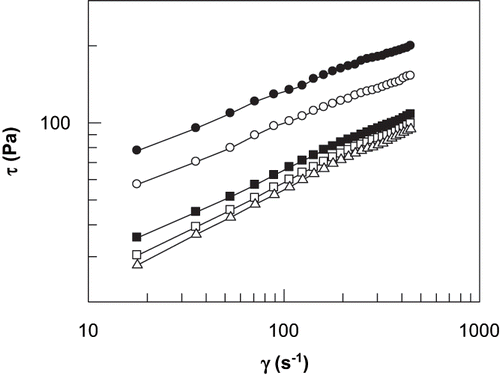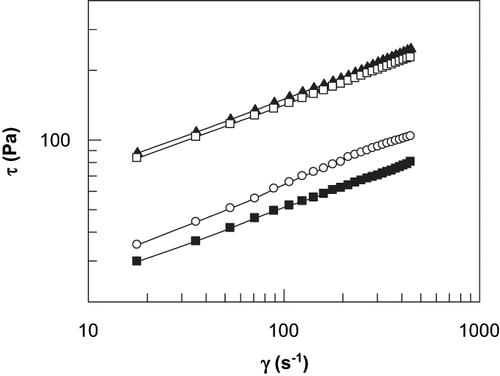Abstract
Seventeen commercial salad sauces, made by different manufacturers, were studied to examine their rheological properties. Rheological studies include determination of the following: (a) flow curves with a controlled shear rate or shear stress, and (b) curves showing the time and temperature dependence of apparent viscosity. Apparent viscosity was correlated using the power-law model. The flow behaviour index, n, and the consistency index, K, were calculated and their variation with the temperature (between 20 and 40°C) was studied. Their values varied between 0.19 and 0.51, for n, and between 2.39 and 60.5, for K.
INTRODUCTION
To assess the quality of semisolid food products, it is necessary to understand their rheological properties. It is known that sauces, which are a semi-solid food, exhibit a non-Newtonian, pseudoplastic flow with a distinct yield stress and thixotropic behaviour.[Citation1] The rheological properties of processed sauces are determined by the size of solid phase particles. Those properties can be created or modified by controlling the particle size distribution (milling degree) in the manufacturing process. The properties of sauces are also influenced by oil fraction and the addition of thickeners.[Citation2]
The increasing social and economic importance of food production, together with the complexity of production technology, processing, handling and acceptance of these highly perishable and fragile food materials require a more extensive knowledge of their physical properties. The viscoelastic properties play an important role in the handling and quality attributes of both minimally processed foods, such as fruits and vegetables, and fabricated foods such as sauces and frankfurters.[Citation3] In the food manufacturing industries food materials undergo a lot of transformations during their processing; therefore, there can be a significant relationship between industrial practice and research studies on properties of foods.
Most foods are subjected to variations in their temperature during production, transport, storage, preparation and consumption, e.g., pasteurization, sterilization, evaporation, cooking, freezing, chilling, etc. Temperature changes may cause alterations in the physical and chemical properties of food components which influence the overall properties of the final product, e.g., taste, appearance, texture and stability. Chemical reactions, such as hydrolysis, oxidation or reduction, may be promoted or physical changes, such as evaporation, melting, crystallization, aggregation or gelation, may occur. A better understanding of the influence of temperature on the properties of foods enables food manufacturers to optimize processing conditions and improve product quality.[Citation4]
In order to understand and eventually improve the processing performance of food sauces, a sound understanding of their flow behaviour is necessary. Because of their commercial importance, the role of various components: oil, water, egg yolk, thickening agents (usually gums), salt and sugar have been studied by food technologists and summarized in some publications.[Citation5–9] The studies undertaken in these works are often employed only at two different temperatures: ambient temperature or in cooked dishes. For this reason, the authors carried out an investigation whose objective was to study the rheological properties of various sauces at a range of temperature.
MATERIALS AND METHODS
The sauces were tested in commercial form. The pH values were controlled with a KRISSON pH-meter. The sauces were classified in four groups: sauces with oil, sauces with milk derivatives, sauces with tomato, and sauces with vinegar. The ingredients present in different sauces are as follows:
-
I. Sauces with oil
-
Sauce 1 (brave sauce): vegetable oil, tomato, mustard, vinegar, sugar, egg yolk, starch, spices, salt, garlic, parsley and preservative (sorbic acid).
-
Sauce 2 (gaucha sauce): vegetable oil, water, tomato concentrate, garlic, sugar, wine vinegar, milk proteins, salt, thickener (starch), spices, lemon juice, preservative (potassium sorbate), stabilizers (carob-bean flour, pectin) and food colour (carotene).
-
Sauce 3 (garlic sauce): vegetable oil, water, natural garlic, egg yolk, wine vinegar, sugar, salt, thickener (starch), lemon juice, stabilizers (carob-bean flour, pectin), preservative (potassium sorbate), and antioxidant (calcium disodium EDTA).
-
Sauce 4 (vegetable sauce for sandwich): vegetable oil, sugar, alcohol vinegar, carrots, gherkins, modified maize starch, onions, egg yolk, red pepper, salt, mustard, mustard seeds, stabilizers, aromas, spices, garlic extract, colorant and extract of plants.
-
Sauce 5 (curry sauce): sunflower oil, water, dextrose, white wine vinegar, egg yolks, salt, thickener (starch, xanthan gum), acidifier (acid lactic), curry, lemon juice concentrate, aromas and colorant.
-
Sauce 6 (mayonnaise): sunflower oil, egg yolk, vinegar, water, sugar, salt, spices and stabilizer (guar gum).
-
-
II. Sauces with milk derivatives
-
Sauce 7 (three cheeses sauces): milk, cream, modified starch, powdered cheese (Stilton, Gorgonzola and Parmesan), salt, butter, proteins, aromas, spices, thickener, lactose, wheat flour and colorant.
-
Sauce 8 (roquefort sauce): Water, Roquefort cheese, cream, thickener (starch), lemon juice, salt, milky protein, flavour enhancer, garlic, emulsifier (fatty acid esters of glycerol) and food colour (patent blue).
-
Sauce 9 (pepper sauce): Water, skimmed milk, thickener (starch), sunflower oil, cream, tomato, aromas, salt, milky protein, flavour enhancer, sugar, colorant (caramel), emulsifier (fatty acid esters of glycerol), cognac, pepper, vegetable extracts and acidity regulator (sodium bicarbonate).
-
Sauce 10 (yoghurt sauce): Water, vegetable oil, powdered yoghurt, wine and alcohol vinegar, egg yolk, thickener (starch), mustard, salt, aromas and antioxidant (calcium disodium EDTA).
-
Sauce 11 (carbonara sauce): Water, cream, bacon, Parmesan cheese, sunflower oil, thickener (E-1422), salt, vegetables (onion, garlic), flavour enhancer, emulgent (fatty acid esters of glycerol), sugar, salt, egg yolk, aroma, spices, acidity regulator and food colour.
-
-
III. Sauces with tomato
-
Sauce 12 (Mexican sauce): Tomato, tomato paste, sugar, glucose syrup, lemon juice, vegetables, apple paste, alcohol vinegar, mustard, salt, starch and spices.
-
Sauce 13 (barbecue sauce): Water, tomato concentrate, mustard, wine vinegar, sugar, worcestershire sauce, salt, garlic, stabilizer (xanthan gum), spices and preservatives (potassium sorbate, sodium benzoate).
-
Sauce 14 (cocktail sauce): Tomato, tomato paste, vegetable oil, sugar, vinegar, egg yolk, mustard sauce, whiskey, starch, salt, aromas and spices.
-
Sauce 15 (ketchup): Water, tomato paste, sucrose, spirit vinegar, salt, thickener (starch), spices and aromas.
-
-
IV. Sauces with vinegar
-
Sauce 16 (bittersweet sauce): water, sugar, glucose syrup, pineapple, apple paste, vinegar, starch, peppers, carrots, salt, onions, ginger, spices, lemon juice and aroma.
-
Sauce 17 (mustard): water, spirit vinegar, mustard, sugars, salt and spices.
-
Rheological Measurements
Various rheological measurements for all sauces were made using a rotational concentric cylinder viscometer HAAKE VT550, equipped with SV1 rotor adequate for viscosity measurements of high viscosity liquids.[Citation10] The viscometer was interfaced to a computer for control and data acquisition. The sample compartment was kept at a constant temperature using a circulator water bath. This apparatus measures the shear rate and apparent viscosity of a fluid at a certain temperature. To study the effect of temperature on apparent viscosity, five measures from 20 to 40°C were carried out.
For each test, the filled sample cup and spindle was first temperature equilibrated for about 20 minutes. The sample was then sheared with a programmed continuous sequence in which the shear rate was increased linearly, from 17.8 to 445 s−1, over a 10 minute period. Shear stress-shear rate data were collected continuously at 30 second intervals throughout the test. In all cases, the temperature of the samples was controlled during measurement with a precision of ±0.1°C. In order to investigate the reproducibility of the results, all samples were subjected to the same standard routine and experiments were performed at least in triplicate.
Most fluid foods do not follow the simple Newtonian rheological model; in other words, their viscosities are dependent on shear rate. Viscosity is also dependent on temperature for all fluids and therefore due to shear rate and temperature both affecting fluid viscosity of non-Newtonian fluids, it is necessary to develop more complex models to describe their behaviour. The flow curves (rheograms) were evaluated by using the power-law model.
RESULTS AND DISCUSSION
Rheograms
Shear stress (τ) versus shear rate (γ) is represented, in for sauce 3 at different temperatures, and in for four sauces at 30°C. From these figures it could be seen that all of these sauces shown a non-Newtonian and pseudoplastic behaviour. In , it is also observed that the shear stress decreases when the temperature increases.
Rheological Parameters
The rheological model most often used to describe the flow behaviour of pseudoplastic foods is the power law
Table 1 Power law parameters.
Figure 3 Influence of shear rate on apparent viscosity for different sauces, at 20 °C, in logarithmic scale. Experimental values: sauce 4 (▵), sauce 6 (□), sauce 2 (•), sauce 16 (○), sauce 10 (▿), and calculate values (-).
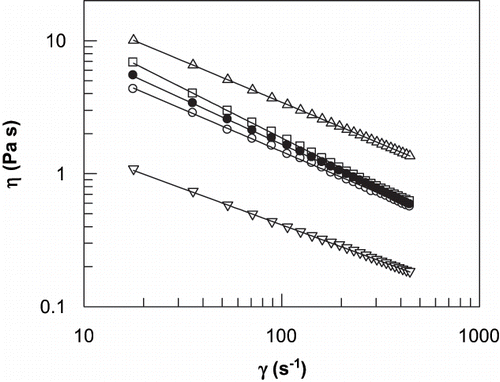
The flow behaviour index is less than unity in all cases; this fact confirms the pseudoplastic behaviour of the sauces. If we analysed the values of flow behaviour index, it was found that the sauces with starch have the highest values (sauces 4, 9, 10, 11, and 16), while the barbecue sauce (sauce 13) has the low value. It does appear possible to predict the behaviour of starch in starch-based sauces, however the presence of other components such as lipids and milk proteins means that the rheological properties of the sauces are not totally predictable.[Citation11] The sauce 13 contains xanthan gun without starch, xanthan molecules are in continuous phase in solutions, and thus achieves high viscosity at low concentrations, and its solutions show thickening properties with pseudoplastic behaviour.[Citation12] Although xanthan gum, an ionic gum, has a higher viscosity than galactomannans at the same gum concentration, it is found to cause the lower increase in the apparent viscosity of the sauces samples than galactomannans.[Citation13]
The variation of flow behaviour index and consistency index with temperature are shown in and for different sauces. The flow behaviour index increases linearly with temperature, while the consistency index, K, decreases linearly when temperature increases:
Figure 4 Flow behaviour index vs. temperature for different sauces: Sauce 5 (▴), sauce 8 (○), sauce 2 (□), sauce 16 (▪), sauce 15 (•), sauce 17 (▵), sauce 9 (▿).
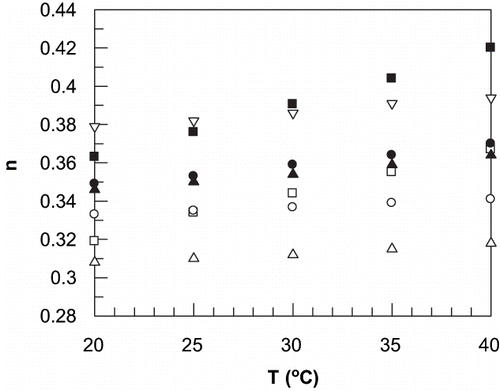
Figure 5 Consistency index vs. temperature for different sauces: Sauce 5 (▴), sauce 8 (○), sauce 2 (□), sauce 16 (▪), sauce 15 (•), sauce 17 (▵), sauce 9 (▿).
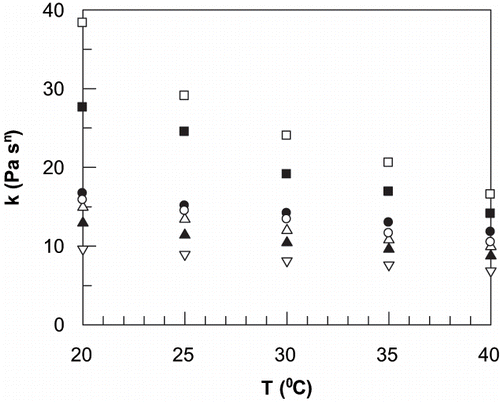
In Equationequations 2 and Equation3, Bi and Ci are fitting parameters in (°C)−i and Pa sn (°C)−i, respectively, and T represents the temperature in °C. The values of the fitting parameters are displayed in .
Table 2 Relationship between power law parameters and temperature.
CONCLUSIONS
The results obtained allowed to conclude that the studied salad sauces have a non-Newtonian and pseudoplastic behaviour. The rheological parameters, n and K, were calculated for seventeen sauces. The flow behaviour index increases linearly with the temperature and the other hand, the consistency index decreases linearly when the temperature increases. The flow behaviour index for sauces with starch is the highest, while the sauces with xanthan gum have relatively lower values.
REFERENCES
- Juszczak , L. , Witczak , M. , Fortuna , T. and Agnieszka , B. 2004 . Rheological Properties of Commercial Mustards . Journal of Food Engineering , 63 : 209 – 217 .
- Bhattacharya , S. , Vasudha , N. and Krishna , K. 2004 . Rheological Behaviour of Processed Mustard. II. Storage Effects . Journal of Food Engineering , 63 : 209 – 217 .
- Rao , M.A. and Steffe , J.F. , eds. 1992 . Viscoelastic Properties of Foods , London : Elsevier Applied Science .
- Osborne , D.R. and Voogt , P. , eds. 1986 . Análisis de los Nutrientes de los Alimentos , Zaragoza : Acribia .
- Franco , J.M. , Algeciras , J.L. , Trujillo , J.E. , Flores , V. and Gallegos , C. 1994 . Influencia del Procesado en la Estabilidad de Emulsiones Alimentarias Aceite en Agua de Bajo Contenido en Aceite . Alimentación, Equipos y Tecnología , 13 ( 3 ) : 61
- Franco , J.M. , Guerrero , A. and Gallegos , C. 1995 . Influencia de las Concentraciones de Aceite y Emulsionante en las Propiedades Reológicas de Emulsiones Aceite en Agua del Tipo Salsa Fina . Grasas y Aceites , 46 ( 2 ) : 108
- Harrison , L. and Cunningham , F. 1986 . Influence of Frozen Storage Time on Properties of Salted Yolk and its Functionality in Mayonnaise . Journal of Food Quality , 9 : 167
- Miranda , J. , Gurrero , A.F. and Partal , P. 2000 . Reología de Derivados de la Yema de Huevo Deshidratada . Grasas y Aceites , 51 ( 4 ) : 244
- Sánchez , M.C. and Guerrero , A. 1998 . Influencia de la Composición y del Procesado Sobre la Reología de Emulsiones . Afinidad , LV : 476 – 259 .
- Álvarez , E. , Cancela , M. A. and Maceiras , R. 2004 . Comparison of Rheological Behaviour of Sweet and Salad Sauces . International Journal of Food Properties , 7 ( 3 ) : 511 – 518 .
- Thebaudin , J-Y. , Lefebvre , A-C. and Doublier , J-L. 1998 . Rheology of Starch Pastes from Starches of Different Origins: Application to Starch-based Sauces . Lebensm.-Wiss. U.-Technol , 31 ( 4 ) : 354 – 360 .
- Casas , J. A. , Santosa , V.E. and García-Ochoa , A. 2000 . Xanthan Gum Production Under Several Operation Conditions: Molecular Structure and Rheological Properties . Enzyme and Microbial Technolology , 26 : 282 – 291 .
- Sahin , H. and Ozdemir , F. 2004 . Effect of Some Hydrocolloids on the Rheological Properties of Different Formulated Ketchups . Food Hydrocolloids , 18 : 1015 – 1022 .
